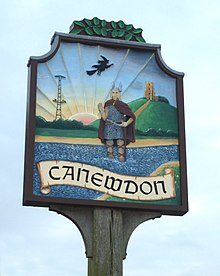Canewdon
| Canewdon | |
|---|---|
 Canewdon Village Sign |
|
| Canewdon shown within Essex | |
| Population | 1,473 (2011) |
| OS grid reference | TQ900945 |
| Civil parish |
|
| District | |
| Shire county | |
| Region | |
| Country | England |
| Sovereign state | United Kingdom |
| Post town | ROCHFORD |
| Postcode district | SS4 |
| Dialling code | 01702 |
| Police | Essex |
| Fire | Essex |
| Ambulance | East of England |
| EU Parliament | East of England |
| UK Parliament | |
Canewdon is a village and civil parish in the Rochford district of Essex, England. The village is located approximately 4 miles (6.4 km) northeast of the town of Rochford, while the parish extends for several miles on the southern side of the River Crouch.
Canewdon is situated on one of the highest hills of the Essex coastline, from which St. Nicholas Church affords wide views of the Crouch estuary. East of the village lies the island of Wallasea, popular for sailing, and a wetland sanctuary for wildlife.
The name Canewdon is derived from Old English words meaning 'hill of the Cana's people' and not, as is sometimes claimed, from Canute the Great.
A number of sites in and around Canewdon reflect occupation of the land from at least the Neolithic period (4,000–2,000 BC). For instance, gravel extraction from early 20th century found prehistoric remains, such as a hoard of Neolithic axes and Iron Age. On display at the National Maritime Museum in Greenwich is a Bronze Age Canewdon paddle.
Canewdon's location was favourable for its vantage point and proximity to the sea for trading and salt production. From Prehistoric and Roman times farmsteads and cemeteries were located on higher ground. Roman urns were found in the village in 1712. Along the coast were Roman Red Hill salterns structures constructed of clay floors heated by flues, dating based upon Romano-British pottery. Salt was used in the ancient diet, for grazing animals, as a refining agent in metallurgy, for soldering and in dyes.
The name Canewdon predates Danish Canute the Great by about 400 years but the area is claimed to be the site of an ancient camp used by Canute, during the Battle of Assandun in the course of his invasion of Essex in 1016. Remains of Canute's camp are thought to be marked in the entrenchments between the village and the river.
...
Wikipedia

